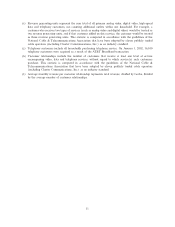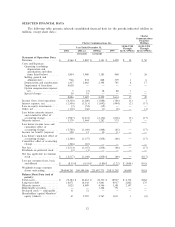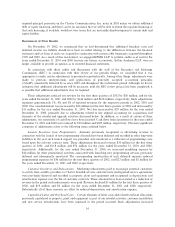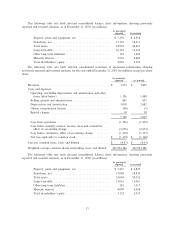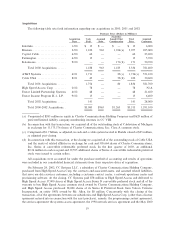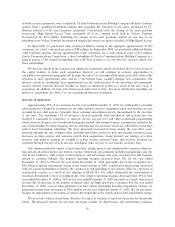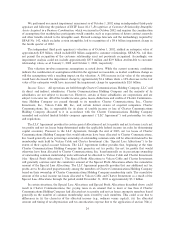Charter 2002 Annual Report Download - page 17
Download and view the complete annual report
Please find page 17 of the 2002 Charter annual report below. You can navigate through the pages in the report by either clicking on the pages listed below, or by using the keyword search tool below to find specific information within the annual report.
operating expenses by $73 million for the Ñrst three quarters of 2002, and $93 million and $52 million for the
years ended December 31, 2001 and 2000, respectively.
Customer Acquisition Costs. Certain customer acquisition campaigns were conducted through third-
party contractors in 2000, 2001 and portions of 2002. The costs of these campaigns were originally deferred
and recorded as other assets and recognized as amortization expense over the average customer contract life.
These amounts have been reported as marketing expense in the period incurred and totaled $32 million for the
Ñrst three quarters of 2002, and $59 million and $4 million and for the years ended December 31, 2001 and
2000, respectively. We discontinued this program in the third quarter of 2002 as contracts for third-party
vendors expired. Substantially all of these amounts are oÅset by reduced depreciation and amortization
expense.
Rebuild and Upgrade of Cable Systems. In 2000, as we were completing our acquisitions, we initiated a
three-year program to replace, upgrade and integrate a substantial portion of our network (the rebuild
program). This rebuild/upgrade of the cable network infrastructure was envisioned as providing the platform
capacity through which many broadband communication services could be provided to the marketplace for
many years to come. Such a rebuild program was unprecedented and is not expected to recur. We began
implementation of this three-year rebuild program in January 2000 and adhered to it over the period. It was
expanded in July 2001 to encompass cable system assets acquired in June 2001 from AT&T Broadband. There
were no other signiÑcant modiÑcations to the rebuild program over the three-year period.
As the rebuild program was beginning in early 2000, we were nearing the end of a period in which we
were acquired by Paul G. Allen and merged with Marcus Cable and in which we had subsequently completed
an initial public oÅering and acquired 16 cable businesses adding approximately 5 million additional
customers. We were faced with integrating these acquisitions, administering the rebuild program and also
putting in place processes and new personnel to handle the increased size and complexity of an operation that
had grown exponentially in a period of about 18 months. During the Ñrst quarter of 2000, management also
recognized the need to reassess depreciable lives of the property that was subject to the three-year rebuild
program. Based on a review of the rebuild program, $3 billion of assets were identiÑed as being subject to
replacement, and accordingly, management reduced the useful lives of those assets. In connection with the
restatement, however, it has been determined that some of these assets were to be retained and not replaced
because sections of the network were scheduled to be upgraded and not rebuilt. In a cable system rebuild there
is outright replacement and retirement of substantially all components of the network, whereas an upgrade
involves the retention of the original property, particularly the Ñber and coaxial cabling.
Presented below is a schedule of the costs of cable distribution system assets subject to the rebuild
program, as originally recorded, reconciled to the Ñnal determinations in the restatement. The depreciation
lives were shortened for this asset pool as discussed previously and supplemented below.
Total
(In millions)
Total asset population subject to rebuild and upgrade, as originally
recorded ÏÏÏÏÏÏÏÏÏÏÏÏÏÏÏÏÏÏÏÏÏÏÏÏÏÏÏÏÏÏÏÏÏÏÏÏÏÏÏÏÏÏÏÏÏÏÏÏÏÏÏÏÏ $ 2,998
Assets which were never intended to be replaced but rather were
upgraded and remain in service ÏÏÏÏÏÏÏÏÏÏÏÏÏÏÏÏÏÏÏÏÏÏÏÏÏÏÏÏÏÏÏÏÏÏ (946)
Cost of assets inadvertently excluded from the asset population ÏÏÏÏÏÏÏÏÏ 401
Adjustment to record acquired assets at depreciated replacement cost at
date of acquisition ÏÏÏÏÏÏÏÏÏÏÏÏÏÏÏÏÏÏÏÏÏÏÏÏÏÏÏÏÏÏÏÏÏÏÏÏÏÏÏÏÏÏÏÏÏ (1,225)
Total adjusted asset value subject to replacement and thus shortened
depreciation life ÏÏÏÏÏÏÏÏÏÏÏÏÏÏÏÏÏÏÏÏÏÏÏÏÏÏÏÏÏÏÏÏÏÏÏÏÏÏÏÏÏÏÏÏÏÏÏ $ 1,228
In connection with the restatement process, we conducted a detailed system-by-system analysis of the
rebuild program to identify those assets which were intended to be rebuilt versus upgraded and determined
that approximately $844 million of trunk and distribution cabling, and $102 million of headend equipment (in
aggregate, $946 million) was enhanced and retained in service. Accordingly, an adjustment was made in the
15








